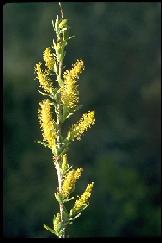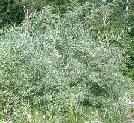
Copyright © 1995 Brother Eric Vogel, St. Mary's College

Copyright © 1995 Brother Eric Vogel, St. Mary's College
Sandbar or Narrow Leaf Willow
Salix exigua Nutt.
Sandbar willow is a short-lived deciduous shrub or small tree
up to about 26 feet tall, with soft weak wood, and thin gray-green to
brown bark.
Staminate and pistillate flowers occur on separate plants as catkins. The fruit
is a narrowly ovoid capsule. The three subspecies as a whole are characterized
as (1) having numerous slender stems, (2) forming thickets through the
underground spread of root suckers, and (3) having long and narrow mature leaves
(5 to 20 times as long as wide) which are equally green on both surfaces. Sandbar willow is able to
reproduce vegetatively by sprouting from underground shoot buds which occur on
lateral roots and produce male or female clones
Sandbar willow is found almost exclusively in riparian
habitats, occupying banks of major rivers and smaller streams, lakes and ponds,
marshy areas, alluvial terraces, and ditches.
It characteristically forms zones immediately adjacent to the water's edge.
Sandbar willow may also occur on moist, well-drained benches and bottomlands.
It normally does not exist in the understory due to its shade intolerance, and
is generally replaced by cottonwoods. It occurs on a wide range of soil types in eastern Idaho and western
Wyoming. Stands in Montana, Wyoming, and Idaho are adjacent to uplands
commonly dominated by conifers, and big sagebrush (Artemisia tridentata) and
Idaho fescue (Festuca idahoensis).
Elevational ranges in
east-central ID ssp. melanopsis: 6,000-7,000 and ssp.
exigua: 3,500 to 3,900 feet.
Medicinal Use
All willows produce salicin, which chemically is closely related to
acetylsalicylic acid, commonly known as aspirin. Native Americans used various
preparations from willows to treat toothache, stomach ache, diarrhea, dysentery,
and dandruff.
Source
Value for Wildlife:
Provides forage for deer and shelter for many game birds.
